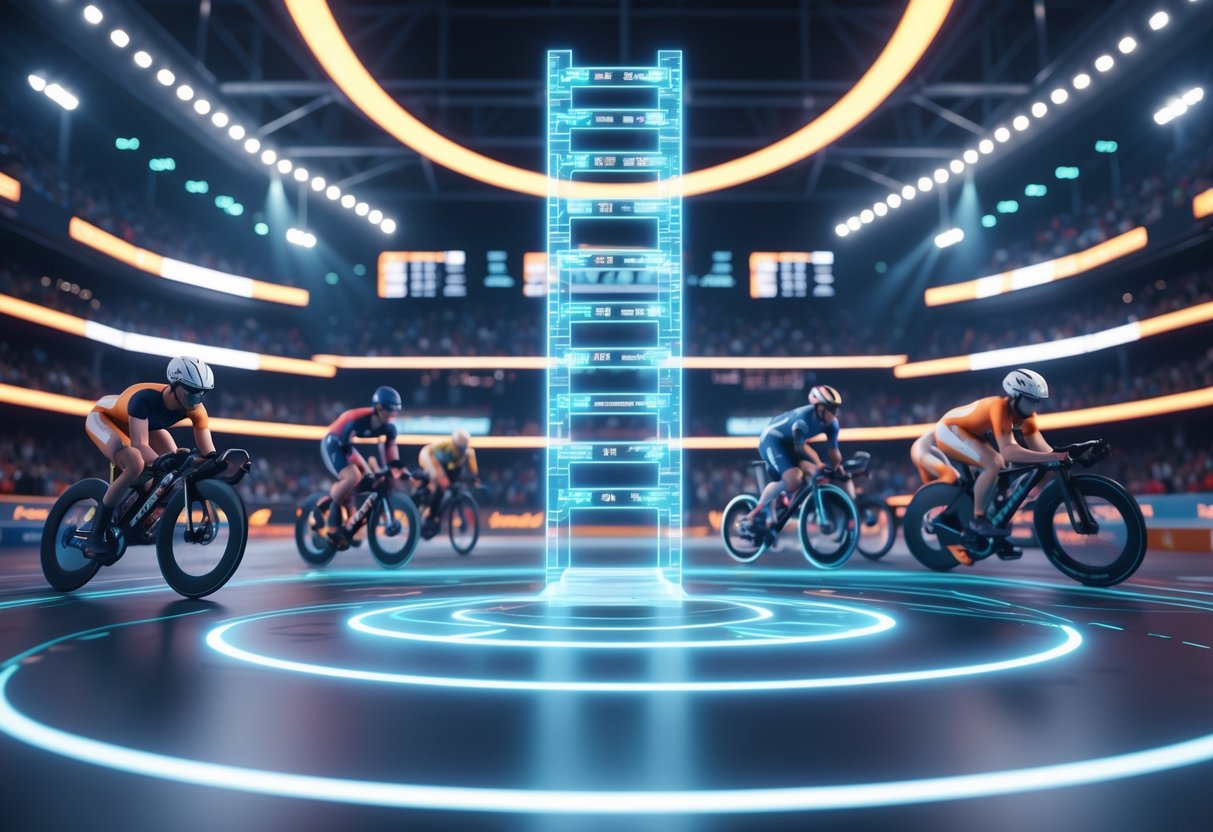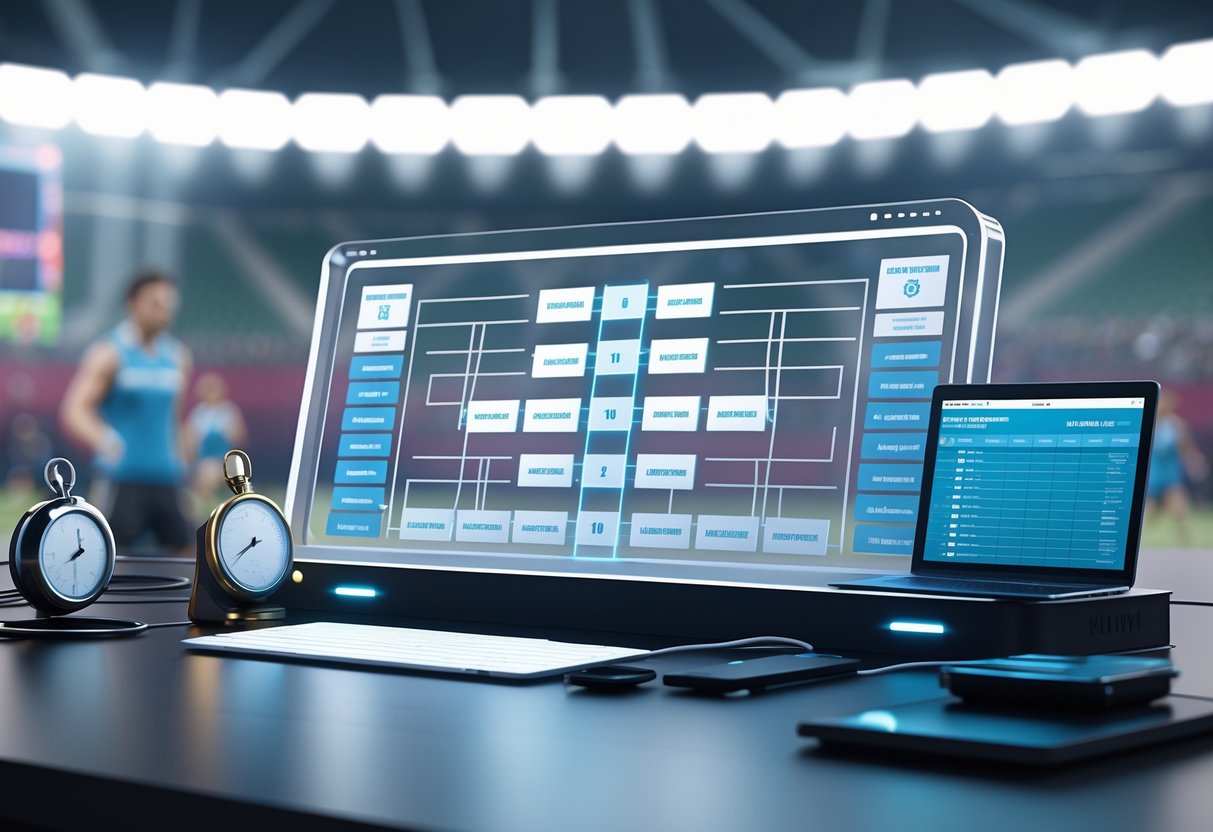Single Elimination Speed: Maximising Fast-Paced Tournament Play
Updated On: October 26, 2025 by Aaron Connolly
What Is Single Elimination Speed?
Single elimination speed is all about how fast tournaments wrap up when you use a format where one loss knocks you out.
This format’s the quickest way to get through a bracket. You’ll get results in hours, not days, since half the players drop out after each round.
Why Single Elimination Is So Fast:
- Immediate elimination – lose once and you’re out.
- Fewer total matches – you only need about half as many games as other formats.
- No second chances – forget losers’ brackets or rematches.
- Linear progression – the path is direct from start to finish.
You only need n-1 matches to find a winner, where n is the number of players. So, for 16 players, you’ll run just 15 matches.
| Tournament Size | Matches Needed | Typical Duration |
|---|---|---|
| 8 players | 7 matches | 2-3 hours |
| 16 players | 15 matches | 4-5 hours |
| 32 players | 31 matches | 6-8 hours |
| 64 players | 63 matches | 1-2 days |
The speed advantage gets wild with bigger tournaments. Double elimination with 64 players? You might need 120+ matches and a full weekend. Single elimination gets it done in a single day.
Organisers love this because it saves money and keeps viewers tuned in. Players don’t have to wait around for days—they get quick, clear results.
Heads up: This speed comes with a price—one bad match and you’re out, no matter how good you are.
How Single Elimination Enables Rapid Tournaments

Single elimination tournaments make things simple by axing half the field after every round. This mathematical efficiency lets tournaments blaze from the first match to the champion’s crowning.
The One-Loss Knockout Principle
The core rule is brutally simple: lose once, you’re out. That’s what drives the crazy speed of single elimination.
Double elimination gives teams another shot in a losers’ bracket. Round-robin makes everyone play everyone. Single elimination? No safety net.
The math is ruthless, but it works. A 64-team bracket only needs 63 matches. Every game boots out one player. You keep going until there’s just one left.
Every match matters. Players can’t afford to experiment or start slow. Teams need to be at peak level right from the start.
Pressure ramps up fast. Quarter-finals feel way heavier than round one, and semi-finals double the nerves again.
Gaming example: Counter-Strike tournaments with single elimination finish in 3-4 days. That’s half the time of double elimination events with the same number of teams.
Number of Matches and Time Saved
Single elimination needs the fewest matches possible to get a winner. The formula’s simple: number of teams minus one.
Tournament size comparison:
- 8 teams: 7 matches (vs 28 in round-robin)
- 16 teams: 15 matches (vs 120 in round-robin)
- 32 teams: 31 matches (vs 496 in round-robin)
- 64 teams: 63 matches (vs 2,016 in round-robin)
This saves a ton of time and money on venues. If you run 16 teams in single elimination, you’re done in a weekend. Round-robin? You’d need a month.
Real-world impact: Big esports events like the FIFA eWorld Cup use single elimination for their finals. They run 32-player knockout rounds in just two days of broadcasts.
It’s not just about match time. Organisers need fewer refs, less gear, and less setup. Venue rental costs drop.
Quick win: For local gaming nights, single elimination means you can run a 16-team bracket in one evening. No need to book out weeks.
Tournament Structure and Bracket Flow
Single elimination brackets follow a tree structure, so scheduling’s a breeze. Each round happens at the same time for all remaining matches.
The bracket flows through these stages:
- Round 1: All first matches
- Quarter-finals: Winners move to semis
- Semi-finals: Two matches decide the finalists
- Final: One match for the trophy
Seeding speeds things up. Top teams get easier early matches, so the best usually don’t knock each other out too soon.
If you don’t have a perfect bracket size, byes fill in the gaps. Teams with byes just wait for round two, and the structure stays tidy.
Venue needs shrink each round. Start with 8 setups? By finals, you only need one.
Broadcast schedules get easier. Fans know exactly when semis and finals happen. No surprise tiebreakers dragging things out like in Swiss or round-robin.
The bracket’s simple look helps viewers keep up. You don’t lose people to confusion as the tournament speeds along.
Key Benefits of Single Elimination Speed

Single elimination gives you fast results with a format where one loss knocks you out. It’s streamlined, efficient, and every match feels like a big deal.
Efficiency in Scheduling
Single elimination slashes tournament time compared to other formats. Events like The International qualifiers get wrapped up in days, not weeks.
The math is straightforward: 16 teams, 15 matches. Every round, half the teams go home.
Organisers save on venues and staff. Quick win: It’s perfect for weekend LANs where renting space gets expensive.
This speed is crucial for big events. The League of Legends World Championship uses single elimination in knockouts to fit everything into broadcast slots.
Practical wins:
- Lower venue costs
- Less staff burnout
- Easier streaming schedules
- Fewer days setting up
Enhanced Excitement and Stakes
Every match is a must-win. Pros say the pressure’s intense—no second chances.
Viewership jumps during single elimination. Twitch saw 40% more concurrent viewers in knockouts compared to group stages.
Fans get invested when their team could be out at any moment. That’s the “March Madness” magic—upsets feel epic.
But: The pressure can really mess with inexperienced teams. Plenty of favorites have crashed out early.
Broadcasters love it. No “dead” matches where the result doesn’t matter.
The sudden-death vibe creates stories. Underdogs knocking out giants? That’s what people remember.
Ideal for Large Participant Numbers
Single elimination handles huge brackets with ease. School events with 128 teams? Seven rounds and you’re done.
Tournament length comparison:
| Participants | Single Elim Rounds | Double Elim Matches | Time Difference |
|---|---|---|---|
| 32 teams | 5 rounds | 62 total matches | 75% faster |
| 64 teams | 6 rounds | 126 total matches | 80% faster |
| 128 teams | 7 rounds | 254 total matches | 85% faster |
Regional qualifiers use single elimination to run through hundreds of teams. FACEIT does this for monthly cups with 500+ players.
Scaling’s easy. More teams just means a couple more rounds, not a crazy jump in matches.
Travel costs stay reasonable. Teams know exactly when they’ll play or be out, so there’s no endless hotel stays.
Drawbacks and Limitations

Single elimination is fast, but it’s not always fair. One bad game can end months of practice, and teams don’t get a shot at redemption.
Increased Element of Luck
Single elimination makes luck a big factor. Weather, tech issues, or a ref’s call can send the best team home after just one match.
A top seed might get their worst possible matchup first. Or maybe they’re dealing with injuries or just having a rough day.
Example: A football team with a 20-win season could lose everything on one penalty in a knockout game.
The format doesn’t care about form swings. Teams have good and bad days, but single elimination catches them at a single point.
This randomness makes things tricky for sponsors and investors. The best team might not win, which can mess with prize money and media coverage.
Limited Chances for Comebacks
Teams can’t learn from mistakes or bounce back. Once you’re out, that’s it—no matter how well you might’ve played in a rematch.
Double elimination shows the difference. Teams have lost their first match and still gone on to win it all through the losers’ bracket.
This creates real mental pressure. Players know one slip could end their run, so they might play too safe or get desperate.
Travel costs sting for teams that get knocked out early. Flying across the country for one short match? That’s tough to justify.
Ranking systems get less data, too. Teams only play a handful of opponents, so it’s hard to judge true skill.
Single Elimination Rounds Explained
Single elimination tournaments use specific names for each round, so you always know how many teams are left. The tournament structure relies on byes and seeding to keep things balanced and fair from the start.
Common Round Naming Conventions
Round names work backwards from the final. The championship is called the final. Before that, you’ve got the semi-final with four teams fighting for two spots.
Then comes the quarter-final—eight teams left. The pattern keeps going for bigger tournaments.
Standard round names:
- Final (2 teams)
- Semi-final (4 teams)
- Quarter-final (8 teams)
- Round of 16 (16 teams)
- Round of 32 (32 teams)
- Round of 64 (64 teams)
Some events use “Sweet Sixteen” instead of “Round of 16” for flair. Esports usually stick with numbers for clarity.
These names help viewers know exactly where the tournament stands. If someone says “quarter-finals,” you know there are eight teams left, fighting for four spots in the semis.
Byes, Seeding, and Early Rounds
Perfect brackets need 2, 4, 8, 16, 32, or 64 players. If you don’t have that, organisers use byes.
A bye means a team skips the first round and moves ahead without playing.
Seeding decides who gets byes and who faces whom. Higher-ranked teams usually get byes and easier openers.
Organisers rank everyone before the event. The #1 seed faces the lowest seed, #2 plays the next-lowest, and so on.
Quick example: In a 12-team bracket, four teams get byes. The other eight play, and winners join the byes in round two, making it eight teams for the next round.
Good seeding keeps things balanced. Without it, top teams might knock each other out early, leaving boring matches later on.
Seeding Systems for Fair Competition

Seeding systems rank players or teams before a tournament begins. Organisers put stronger competitors in different parts of the bracket.
This way, the best players don’t meet too early. The tournament stays balanced, at least in theory.
Why Seeds Are Used
Seeds tackle a big problem in single elimination tournaments. Without them, two top players could clash in the very first round.
The stronger player moves on, but we miss out on that dream final. Meanwhile, the other side of the bracket gets a much easier ride.
Seeding helps by:
- Keeping top competitors apart
- Letting lower-ranked players have a shot
- Making the later rounds more exciting
Organisers usually look at past performance when assigning seeds. They check win-loss records, recent tournament results, and expert rankings to figure out the order.
Common seeding factors:
- How players finished in previous tournaments
- Head-to-head matchups
- Current form and recent wins
- What expert panels think
Seeds aren’t flawless. Sometimes a “dark horse” knocks out a seeded player early, which stirs up excitement and plenty of chatter among fans.
How Seeding Improves Tournament Flow
Good seeding makes tournaments smoother. Early rounds feel more predictable, while later ones get way more intense.
Here’s the basic seeding effect:
- Round 1: Seeds usually win, weaker players go home
- Quarterfinals: Seeds start battling each other
- Semifinals: Top seeds face their toughest opponents
- Final: The two strongest left fight for the win
Fans stay engaged this way. We don’t lose the big names right at the start, and the excitement builds round by round.
Seeding also helps with scheduling and broadcasting. Organisers can plan for the most popular matches and put them in prime time.
Broadcasting perks:
- Top seeds get the best time slots
- Commentators have better stories to tell
- Audience numbers become more predictable
- There’s more potential for ad revenue
Bad seeding can ruin a tournament fast. If organisers misjudge the rankings, we might get boring finals or shocking early exits that turn viewers away.
Popular Uses and Sporting Examples

Single elimination tournaments are everywhere—traditional sports, online games, you name it. They finish quickly, which is why major championships and huge esports events love this format.
Major Events Featuring Single Elimination
The FIFA World Cup knockout stage is a perfect example. After group play, 16 teams face off in sudden death matches until only one remains. Football giants can fall to underdogs in just 90 minutes, and those are the moments fans remember forever.
Tennis tournaments like Wimbledon use single elimination from start to finish. Players compete match by match, and one loss means you’re out—world ranking doesn’t save you.
March Madness turns American college basketball into a wild national event. 68 teams, six rounds, and fans everywhere fill out brackets hoping to pick the winners. It’s a betting frenzy every year.
The NFL playoffs cut teams out week by week until the Super Bowl. Every match could be someone’s last, so TV audiences go through the roof. The pressure just keeps building.
Online Competitive and Esports Tournaments
Esports tournaments run single elimination brackets with thousands of players or teams. Games like Counter-Strike and League of Legends hold online qualifiers where hundreds of squads fight for a few coveted spots at the big events.
Battle royale games fit single elimination perfectly. Fortnite World Cup qualifiers chopped down the field each week until only the very best reached the finals. The format matches the game’s “last one standing” vibe.
Fighting game tournaments at events like EVO use bracket pools that lead into single elimination playoffs. Once players reach the top 8, every match is do-or-die. The community thrives on this “losers go home” energy, and it’s become a core part of competitive esports culture.
Platforms like Battlefy and Toornament handle thousands of these tournaments every month. Some are just for fun, but others offer serious cash prizes.
Comparison with Alternative Systems

Single elimination is fast and simple, but it’s not the only way to run a tournament. Double elimination and round robin systems offer different perks—more fairness, more matches, and sometimes, just more chaos.
Single vs Double Elimination
Double elimination gives everyone a second chance. There’s a winner’s bracket and a loser’s bracket, so you have to lose twice to be out. That’s great for players, but it takes a lot more time.
Time needed:
- Single elimination: 7 rounds for 128 teams
- Double elimination: Up to 13 rounds for 128 teams
With a loser’s bracket, tournaments can drag on. Events like EVO sometimes run 12-14 hours a day, just to get through it all.
Double elimination perks:
- Early upsets don’t end your run
- More matches, more content for viewers
- Technical hiccups or bad luck hurt less
Still, single elimination stays popular because it’s easy to follow. No one has to keep track of two brackets at once.
Single Elimination vs Round Robin
Round robin means every player or team faces everyone else at least once. That’s thorough, but it takes forever.
Number of matches:
- Single elimination (16 teams): 15 matches
- Round robin (16 teams): 120 matches
Round robin works best for leagues, like the League of Legends Championship Series. Teams play 18 matches in the regular season, spread out over months.
Main differences:
- Round robin removes luck from bracket draws
- Every team gets the same number of matches
- Single elimination brings knockout drama that round robin just can’t match
Most big esports events mix things up—group stages might be round robin, but the playoffs usually go single elimination for the drama.
Strategies for Success in Fast Elimination Formats
Fast elimination formats don’t leave much room for mistakes. If you want to win, you need to be ready—physically, mentally, and emotionally.
Preparation and Match Readiness
Pre-tournament prep is huge when you only get one shot. Practise your opening moves until they’re second nature. That way, you won’t trip up right at the start.
Warm-ups should feel just like the real thing. Many players spend 30-45 minutes before matches drilling the exact combos or strats they’ll use.
Check your gear—twice. One controller glitch or bad internet connection and you’re out. Pros always bring backups, just in case.
Time between matches can be short—sometimes just 10-15 minutes. Have a quick checklist ready:
- Check your equipment
- Reset your mindset
- Watch a bit of your next opponent if you can
If you have time, study your opponents. Even a five-minute review can show you their habits or weak spots.
Mindset for Sudden-Death Scenarios
Handling pressure is what separates champions from early exits. James Connolly, a gaming expert, says lots of great players lose because they overthink the stakes.
Focus on your process, not the outcome. Instead of stressing about losing, just stick to your gameplan.
Sometimes, you need to take risks. Playing too safe can backfire—sometimes you’ve got to push for the win, but don’t get reckless.
Have a reset routine for bad moments. Even a 10-second breathing break can stop a bad round from spiraling.
Accept that single elimination is about consistency, not perfection. You don’t have to play flawlessly—just avoid big mistakes and pounce when your opponent slips up.
Considerations for Organisers

Single-elimination tournaments move fast, but that speed brings its own set of headaches. Organisers need to plan carefully and keep players happy to make sure everything runs smoothly.
Scheduling and Match Flow Optimisation
Match spacing can make or break your event. Give 15-30 minutes between rounds so players can set up and reset mentally. Too little time leads to burnout, too much kills the vibe.
For big tournaments, use staggered brackets. Run matches on multiple setups to keep things moving. Nobody wants to wait hours between games.
Build in buffer time—add about 20% extra to your schedule for tech problems or long matches. Rushing just leads to mistakes and unhappy players.
Think about player logistics. Group nearby players together in early rounds so they don’t have to run all over the place. It keeps things on track.
Standardise the technical setup. Give 5 minutes between matches for equipment checks and briefings. Clear protocols help everyone know what’s expected.
Managing Player Experience
Good communication solves most problems. Use Discord or your tournament platform to send real-time updates about matches, bracket changes, or tech issues.
Put up clear signs and set up waiting areas. Players need to know where to go and when. Confusion slows everything down.
Let players warm up before each round, even if it’s just a couple of minutes. Cold starts lead to bad games and complaints.
Help players with stress management. Single-elimination is nerve-wracking. Have staff ready to answer questions or sort out disputes quickly.
Don’t forget food and water—players need to stay sharp, especially during long days. Even just water bottles and snacks make a big difference.
Adapting Single Elimination Speed in Digital Platforms

Digital platforms have made single elimination tournaments much faster. These days, bracket updates and match notifications happen in seconds, not minutes.
Online Tournament Tools
Platforms like Challonge, Battlefy, and Toornament have changed the game. No more waiting around for someone to update the bracket by hand.
Major speed boosts:
- Automatic seeding by registration or ranking
- Instant bracket creation, even for hundreds of players
- Built-in check-in to avoid delays
- Mobile notifications for everyone
Challonge is great for small events. Battlefy handles massive tournaments with thousands of players. Most have free options, but watch out—free tiers usually cap you at 64-128 participants.
Brackets and Real-Time Updates
Real-time bracket updates keep things moving. Players see results right away instead of waiting for someone to make an announcement.
Modern platforms send push notifications when your next match is ready. That cuts out those 10-15 minute gaps that used to drag tournaments down.
Must-have features:
- Live score reporting by officials
- Automatic progression to the next round
- Messaging for participants
- Stream overlays for broadcasts
Now, Discord bots can sync with these platforms and announce results instantly. That keeps the whole community in the loop and stops confusion.
Some digital tournaments finish a 64-player bracket in under three hours. Paper brackets used to take twice as long for the same thing.
Frequently Asked Questions

Single elimination speed tournaments always raise questions about how the format works, how to prepare, and whether it’s really fair. Understanding these quirks helps both players and fans handle the wild ride of high-speed knockout competitions.
How does a single elimination tournament work?
Single elimination’s about as straightforward as it gets—win and move on, lose and you’re out. There aren’t any do-overs or consolation rounds.
If you keep winning, you’ll keep advancing. But the second you lose, that’s it—your tournament’s over.
Each round, the bracket shrinks. Start with 64 players, then there’s 32, then 16, then 8, and so on, until just one’s left standing.
Can you explain the seeding process for speed competitions used in single elimination formats?
Seeding basically means ranking the players by skill or past results. Usually, the top seed faces the lowest seed in the first round to keep things balanced.
Organizers look at recent results, rankings, and head-to-head records to figure out who gets which seed. That way, the best players don’t knock each other out too early.
Higher seeds get a bit of an easier path in the beginning. If you’re a lower seed, you’ve got to face tougher opponents right away.
What’s the best strategy for competitors to prepare for a single elimination event?
Honestly, mental prep matters a lot here. There’s no margin for error, so you’ve got to practice performing under pressure.
Stick to what you know works best. Single elimination usually favors players who stay consistent, not those who get fancy with new tactics.
Take time to study possible opponents. It helps to have a plan for different matchups you might run into in your part of the bracket.
How do tiebreakers function in a single elimination tournament?
Most speed tournaments use sudden death if there’s a tie—first to score or finish wins, plain and simple.
Some events rely on things like accuracy, time left, or previous head-to-head results, but the rules spell that out before things start.
For team events, organizers might use aggregate scoring or penalty rounds. You’ll want to check the tournament regulations since tiebreakers can really differ.
What are the typical time controls for matches in single elimination speed tournaments?
Speed tournaments almost always use shorter time limits than standard events. Matches can last anywhere from 3 to 10 minutes, depending on the game.
In chess, you’ll see time controls like 3+2 (three minutes, plus two seconds per move) or 5+0 (five minutes total). Fighting games? Usually 99 seconds per round.
Organizers try to balance excitement and fairness. Short matches can lead to upsets, but longer ones tend to reward the most skilled players.
How is the fixture list determined in single elimination speed tournaments?
Organizers build the bracket around how many people are playing. If you get a power-of-two number—like 16, 32, or 64—you end up with a nice, balanced bracket.
When there aren’t enough people to hit those numbers, some players get “byes.” Usually, higher-seeded competitors land those byes, which gives them a bit of an edge.
People running the event use draw ceremonies or software to slot everyone into the bracket. They make sure to keep the top seeds apart so those big matchups don’t happen too soon.

